Report: Discrimination and Engagement of Aboriginal Australians
VerifiedAdded on 2020/07/22
|13
|3972
|67
Report
AI Summary
This report examines the discrimination and engagement of Aboriginal and Torres Strait Islander peoples in Australia. It explores the historical and ongoing challenges these communities face, including socioeconomic disparities, workplace discrimination, and health inequalities. The report highlights the impact of cultural differences and societal biases, analyzing factors such as environmental, social, and political influences. It also discusses the importance of cultural understanding and effective engagement strategies to promote equality and improve the living conditions of Aboriginal and Torres Strait Islander communities. The analysis covers the impact of othering, racial discrimination, and the role of government policies in addressing these issues, emphasizing the need for improved healthcare, cultural awareness, and social justice initiatives. The report emphasizes the need to understand the complex interplay of cultural diversity and social inequality to promote equity and inclusion for all Australians.
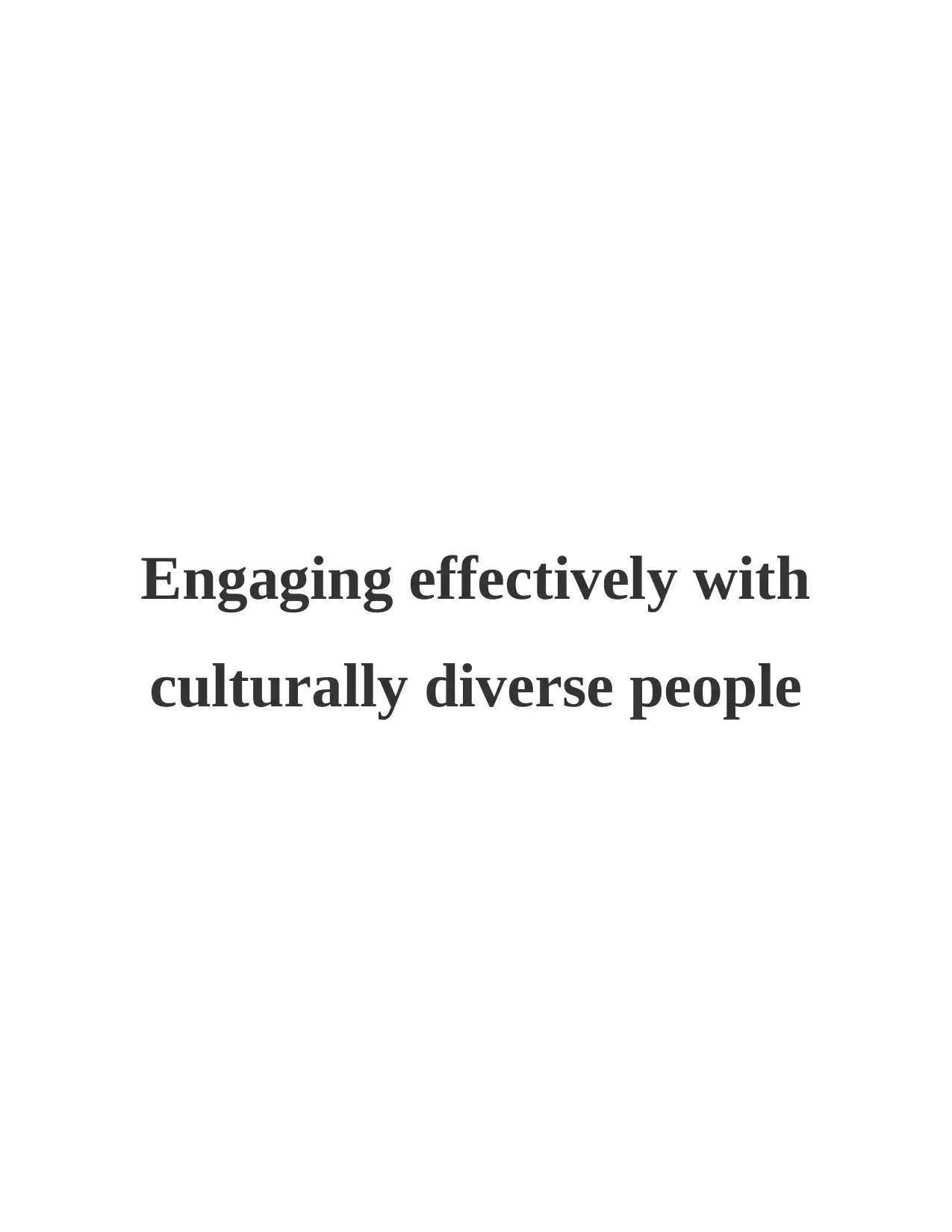
Engaging effectively with
culturally diverse people
culturally diverse people
Paraphrase This Document
Need a fresh take? Get an instant paraphrase of this document with our AI Paraphraser
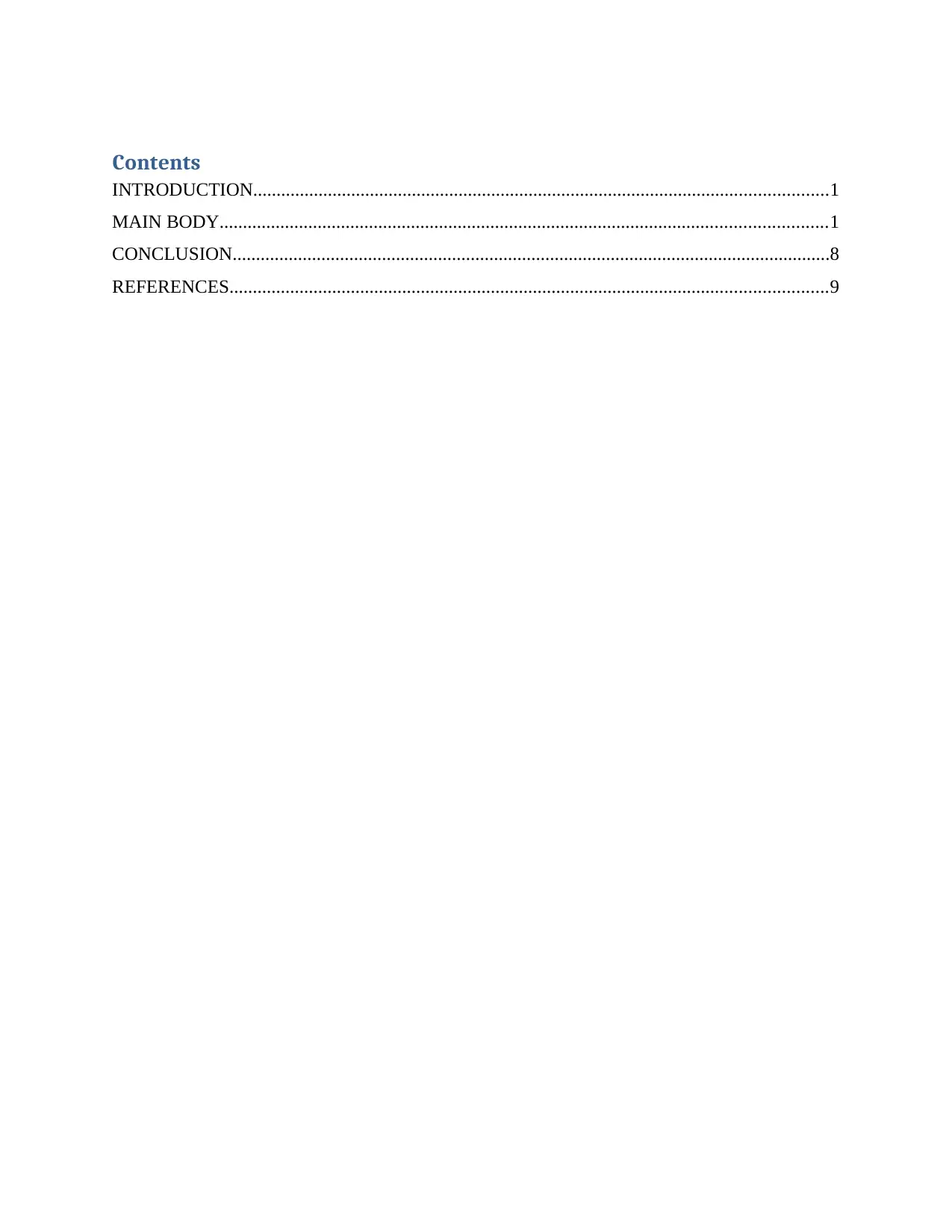
Contents
INTRODUCTION...........................................................................................................................1
MAIN BODY..................................................................................................................................1
CONCLUSION................................................................................................................................8
REFERENCES................................................................................................................................9
INTRODUCTION...........................................................................................................................1
MAIN BODY..................................................................................................................................1
CONCLUSION................................................................................................................................8
REFERENCES................................................................................................................................9
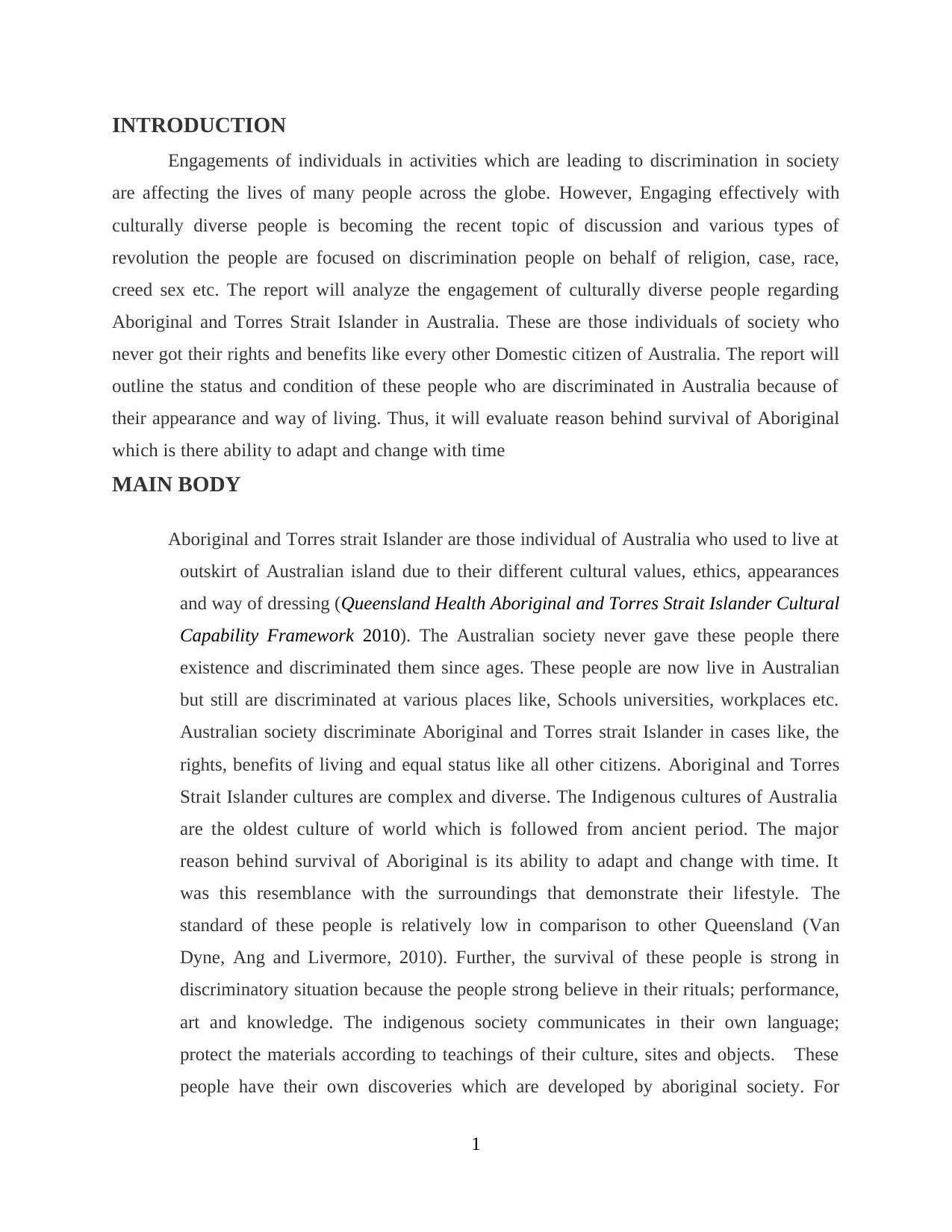
INTRODUCTION
Engagements of individuals in activities which are leading to discrimination in society
are affecting the lives of many people across the globe. However, Engaging effectively with
culturally diverse people is becoming the recent topic of discussion and various types of
revolution the people are focused on discrimination people on behalf of religion, case, race,
creed sex etc. The report will analyze the engagement of culturally diverse people regarding
Aboriginal and Torres Strait Islander in Australia. These are those individuals of society who
never got their rights and benefits like every other Domestic citizen of Australia. The report will
outline the status and condition of these people who are discriminated in Australia because of
their appearance and way of living. Thus, it will evaluate reason behind survival of Aboriginal
which is there ability to adapt and change with time
MAIN BODY
Aboriginal and Torres strait Islander are those individual of Australia who used to live at
outskirt of Australian island due to their different cultural values, ethics, appearances
and way of dressing (Queensland Health Aboriginal and Torres Strait Islander Cultural
Capability Framework 2010). The Australian society never gave these people there
existence and discriminated them since ages. These people are now live in Australian
but still are discriminated at various places like, Schools universities, workplaces etc.
Australian society discriminate Aboriginal and Torres strait Islander in cases like, the
rights, benefits of living and equal status like all other citizens. Aboriginal and Torres
Strait Islander cultures are complex and diverse. The Indigenous cultures of Australia
are the oldest culture of world which is followed from ancient period. The major
reason behind survival of Aboriginal is its ability to adapt and change with time. It
was this resemblance with the surroundings that demonstrate their lifestyle. The
standard of these people is relatively low in comparison to other Queensland (Van
Dyne, Ang and Livermore, 2010). Further, the survival of these people is strong in
discriminatory situation because the people strong believe in their rituals; performance,
art and knowledge. The indigenous society communicates in their own language;
protect the materials according to teachings of their culture, sites and objects. These
people have their own discoveries which are developed by aboriginal society. For
1
Engagements of individuals in activities which are leading to discrimination in society
are affecting the lives of many people across the globe. However, Engaging effectively with
culturally diverse people is becoming the recent topic of discussion and various types of
revolution the people are focused on discrimination people on behalf of religion, case, race,
creed sex etc. The report will analyze the engagement of culturally diverse people regarding
Aboriginal and Torres Strait Islander in Australia. These are those individuals of society who
never got their rights and benefits like every other Domestic citizen of Australia. The report will
outline the status and condition of these people who are discriminated in Australia because of
their appearance and way of living. Thus, it will evaluate reason behind survival of Aboriginal
which is there ability to adapt and change with time
MAIN BODY
Aboriginal and Torres strait Islander are those individual of Australia who used to live at
outskirt of Australian island due to their different cultural values, ethics, appearances
and way of dressing (Queensland Health Aboriginal and Torres Strait Islander Cultural
Capability Framework 2010). The Australian society never gave these people there
existence and discriminated them since ages. These people are now live in Australian
but still are discriminated at various places like, Schools universities, workplaces etc.
Australian society discriminate Aboriginal and Torres strait Islander in cases like, the
rights, benefits of living and equal status like all other citizens. Aboriginal and Torres
Strait Islander cultures are complex and diverse. The Indigenous cultures of Australia
are the oldest culture of world which is followed from ancient period. The major
reason behind survival of Aboriginal is its ability to adapt and change with time. It
was this resemblance with the surroundings that demonstrate their lifestyle. The
standard of these people is relatively low in comparison to other Queensland (Van
Dyne, Ang and Livermore, 2010). Further, the survival of these people is strong in
discriminatory situation because the people strong believe in their rituals; performance,
art and knowledge. The indigenous society communicates in their own language;
protect the materials according to teachings of their culture, sites and objects. These
people have their own discoveries which are developed by aboriginal society. For
1
⊘ This is a preview!⊘
Do you want full access?
Subscribe today to unlock all pages.

Trusted by 1+ million students worldwide
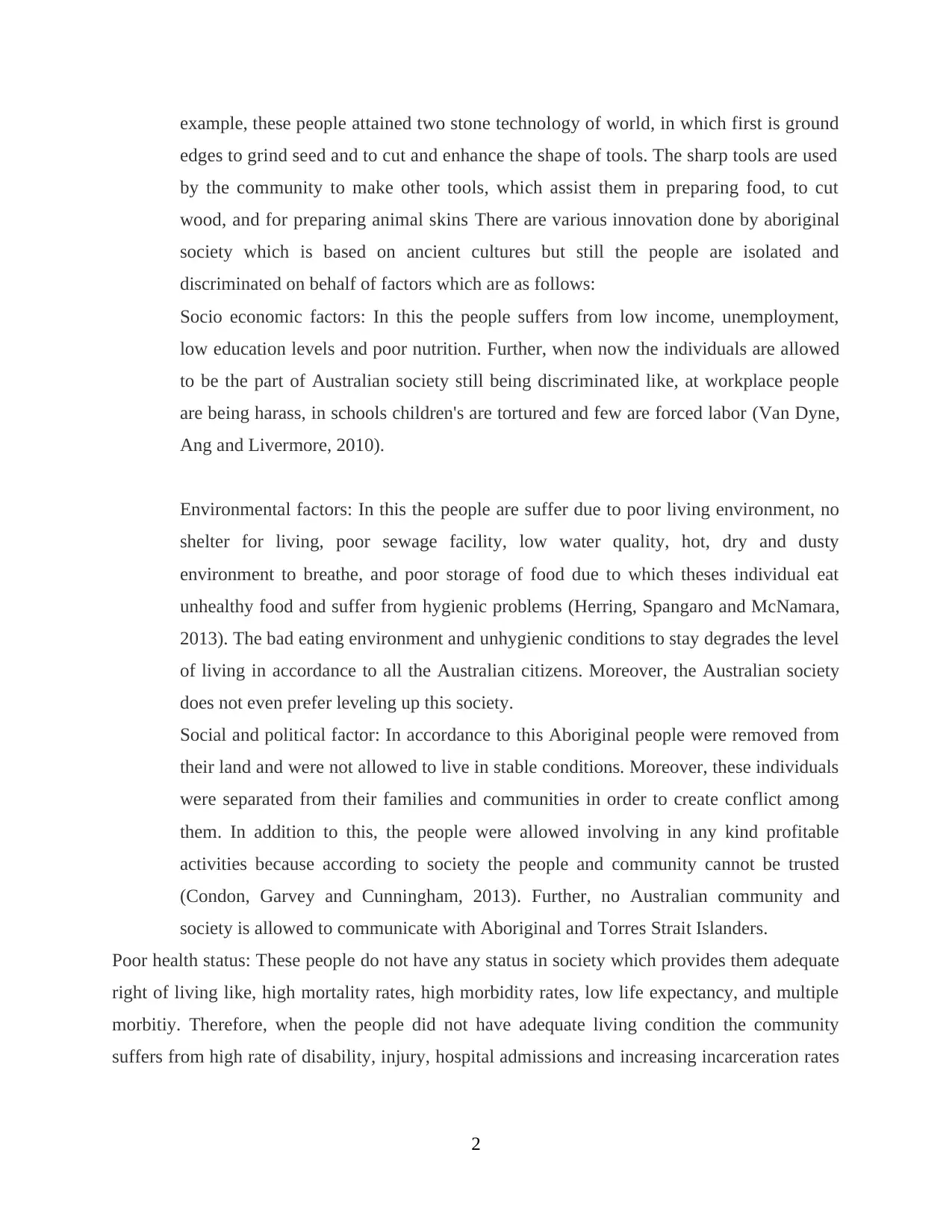
example, these people attained two stone technology of world, in which first is ground
edges to grind seed and to cut and enhance the shape of tools. The sharp tools are used
by the community to make other tools, which assist them in preparing food, to cut
wood, and for preparing animal skins There are various innovation done by aboriginal
society which is based on ancient cultures but still the people are isolated and
discriminated on behalf of factors which are as follows:
Socio economic factors: In this the people suffers from low income, unemployment,
low education levels and poor nutrition. Further, when now the individuals are allowed
to be the part of Australian society still being discriminated like, at workplace people
are being harass, in schools children's are tortured and few are forced labor (Van Dyne,
Ang and Livermore, 2010).
Environmental factors: In this the people are suffer due to poor living environment, no
shelter for living, poor sewage facility, low water quality, hot, dry and dusty
environment to breathe, and poor storage of food due to which theses individual eat
unhealthy food and suffer from hygienic problems (Herring, Spangaro and McNamara,
2013). The bad eating environment and unhygienic conditions to stay degrades the level
of living in accordance to all the Australian citizens. Moreover, the Australian society
does not even prefer leveling up this society.
Social and political factor: In accordance to this Aboriginal people were removed from
their land and were not allowed to live in stable conditions. Moreover, these individuals
were separated from their families and communities in order to create conflict among
them. In addition to this, the people were allowed involving in any kind profitable
activities because according to society the people and community cannot be trusted
(Condon, Garvey and Cunningham, 2013). Further, no Australian community and
society is allowed to communicate with Aboriginal and Torres Strait Islanders.
Poor health status: These people do not have any status in society which provides them adequate
right of living like, high mortality rates, high morbidity rates, low life expectancy, and multiple
morbitiy. Therefore, when the people did not have adequate living condition the community
suffers from high rate of disability, injury, hospital admissions and increasing incarceration rates
2
edges to grind seed and to cut and enhance the shape of tools. The sharp tools are used
by the community to make other tools, which assist them in preparing food, to cut
wood, and for preparing animal skins There are various innovation done by aboriginal
society which is based on ancient cultures but still the people are isolated and
discriminated on behalf of factors which are as follows:
Socio economic factors: In this the people suffers from low income, unemployment,
low education levels and poor nutrition. Further, when now the individuals are allowed
to be the part of Australian society still being discriminated like, at workplace people
are being harass, in schools children's are tortured and few are forced labor (Van Dyne,
Ang and Livermore, 2010).
Environmental factors: In this the people are suffer due to poor living environment, no
shelter for living, poor sewage facility, low water quality, hot, dry and dusty
environment to breathe, and poor storage of food due to which theses individual eat
unhealthy food and suffer from hygienic problems (Herring, Spangaro and McNamara,
2013). The bad eating environment and unhygienic conditions to stay degrades the level
of living in accordance to all the Australian citizens. Moreover, the Australian society
does not even prefer leveling up this society.
Social and political factor: In accordance to this Aboriginal people were removed from
their land and were not allowed to live in stable conditions. Moreover, these individuals
were separated from their families and communities in order to create conflict among
them. In addition to this, the people were allowed involving in any kind profitable
activities because according to society the people and community cannot be trusted
(Condon, Garvey and Cunningham, 2013). Further, no Australian community and
society is allowed to communicate with Aboriginal and Torres Strait Islanders.
Poor health status: These people do not have any status in society which provides them adequate
right of living like, high mortality rates, high morbidity rates, low life expectancy, and multiple
morbitiy. Therefore, when the people did not have adequate living condition the community
suffers from high rate of disability, injury, hospital admissions and increasing incarceration rates
2
Paraphrase This Document
Need a fresh take? Get an instant paraphrase of this document with our AI Paraphraser
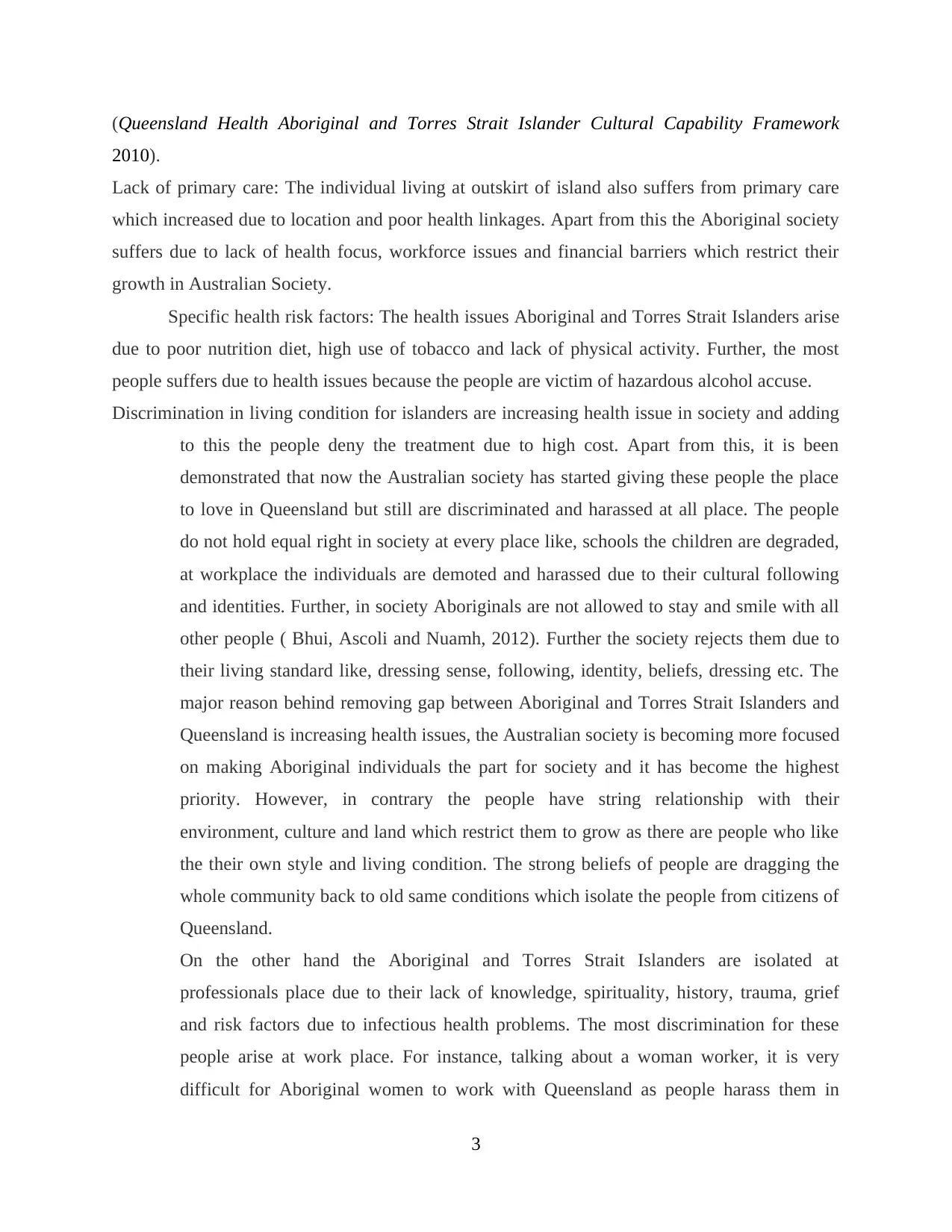
(Queensland Health Aboriginal and Torres Strait Islander Cultural Capability Framework
2010).
Lack of primary care: The individual living at outskirt of island also suffers from primary care
which increased due to location and poor health linkages. Apart from this the Aboriginal society
suffers due to lack of health focus, workforce issues and financial barriers which restrict their
growth in Australian Society.
Specific health risk factors: The health issues Aboriginal and Torres Strait Islanders arise
due to poor nutrition diet, high use of tobacco and lack of physical activity. Further, the most
people suffers due to health issues because the people are victim of hazardous alcohol accuse.
Discrimination in living condition for islanders are increasing health issue in society and adding
to this the people deny the treatment due to high cost. Apart from this, it is been
demonstrated that now the Australian society has started giving these people the place
to love in Queensland but still are discriminated and harassed at all place. The people
do not hold equal right in society at every place like, schools the children are degraded,
at workplace the individuals are demoted and harassed due to their cultural following
and identities. Further, in society Aboriginals are not allowed to stay and smile with all
other people ( Bhui, Ascoli and Nuamh, 2012). Further the society rejects them due to
their living standard like, dressing sense, following, identity, beliefs, dressing etc. The
major reason behind removing gap between Aboriginal and Torres Strait Islanders and
Queensland is increasing health issues, the Australian society is becoming more focused
on making Aboriginal individuals the part for society and it has become the highest
priority. However, in contrary the people have string relationship with their
environment, culture and land which restrict them to grow as there are people who like
the their own style and living condition. The strong beliefs of people are dragging the
whole community back to old same conditions which isolate the people from citizens of
Queensland.
On the other hand the Aboriginal and Torres Strait Islanders are isolated at
professionals place due to their lack of knowledge, spirituality, history, trauma, grief
and risk factors due to infectious health problems. The most discrimination for these
people arise at work place. For instance, talking about a woman worker, it is very
difficult for Aboriginal women to work with Queensland as people harass them in
3
2010).
Lack of primary care: The individual living at outskirt of island also suffers from primary care
which increased due to location and poor health linkages. Apart from this the Aboriginal society
suffers due to lack of health focus, workforce issues and financial barriers which restrict their
growth in Australian Society.
Specific health risk factors: The health issues Aboriginal and Torres Strait Islanders arise
due to poor nutrition diet, high use of tobacco and lack of physical activity. Further, the most
people suffers due to health issues because the people are victim of hazardous alcohol accuse.
Discrimination in living condition for islanders are increasing health issue in society and adding
to this the people deny the treatment due to high cost. Apart from this, it is been
demonstrated that now the Australian society has started giving these people the place
to love in Queensland but still are discriminated and harassed at all place. The people
do not hold equal right in society at every place like, schools the children are degraded,
at workplace the individuals are demoted and harassed due to their cultural following
and identities. Further, in society Aboriginals are not allowed to stay and smile with all
other people ( Bhui, Ascoli and Nuamh, 2012). Further the society rejects them due to
their living standard like, dressing sense, following, identity, beliefs, dressing etc. The
major reason behind removing gap between Aboriginal and Torres Strait Islanders and
Queensland is increasing health issues, the Australian society is becoming more focused
on making Aboriginal individuals the part for society and it has become the highest
priority. However, in contrary the people have string relationship with their
environment, culture and land which restrict them to grow as there are people who like
the their own style and living condition. The strong beliefs of people are dragging the
whole community back to old same conditions which isolate the people from citizens of
Queensland.
On the other hand the Aboriginal and Torres Strait Islanders are isolated at
professionals place due to their lack of knowledge, spirituality, history, trauma, grief
and risk factors due to infectious health problems. The most discrimination for these
people arise at work place. For instance, talking about a woman worker, it is very
difficult for Aboriginal women to work with Queensland as people harass them in
3
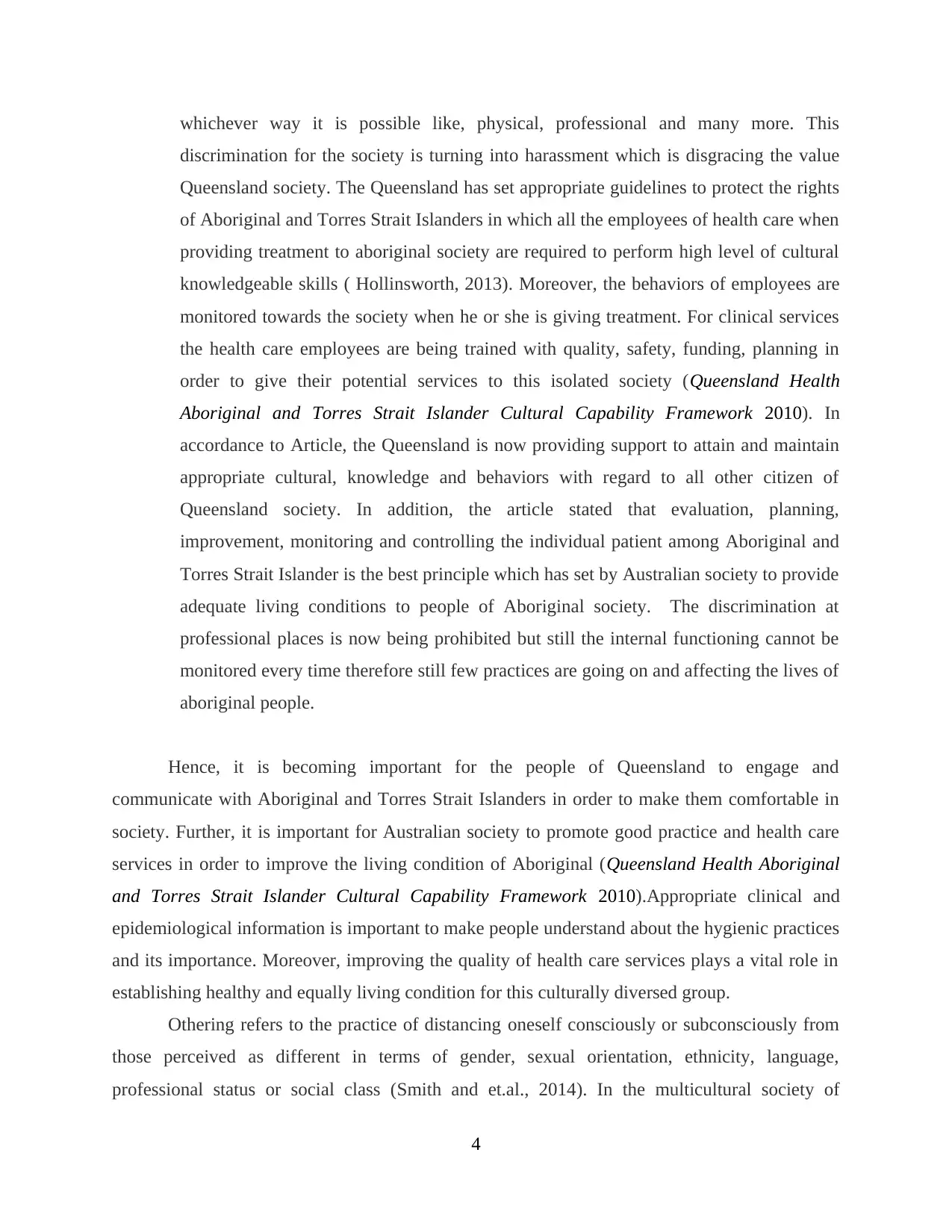
whichever way it is possible like, physical, professional and many more. This
discrimination for the society is turning into harassment which is disgracing the value
Queensland society. The Queensland has set appropriate guidelines to protect the rights
of Aboriginal and Torres Strait Islanders in which all the employees of health care when
providing treatment to aboriginal society are required to perform high level of cultural
knowledgeable skills ( Hollinsworth, 2013). Moreover, the behaviors of employees are
monitored towards the society when he or she is giving treatment. For clinical services
the health care employees are being trained with quality, safety, funding, planning in
order to give their potential services to this isolated society (Queensland Health
Aboriginal and Torres Strait Islander Cultural Capability Framework 2010). In
accordance to Article, the Queensland is now providing support to attain and maintain
appropriate cultural, knowledge and behaviors with regard to all other citizen of
Queensland society. In addition, the article stated that evaluation, planning,
improvement, monitoring and controlling the individual patient among Aboriginal and
Torres Strait Islander is the best principle which has set by Australian society to provide
adequate living conditions to people of Aboriginal society. The discrimination at
professional places is now being prohibited but still the internal functioning cannot be
monitored every time therefore still few practices are going on and affecting the lives of
aboriginal people.
Hence, it is becoming important for the people of Queensland to engage and
communicate with Aboriginal and Torres Strait Islanders in order to make them comfortable in
society. Further, it is important for Australian society to promote good practice and health care
services in order to improve the living condition of Aboriginal (Queensland Health Aboriginal
and Torres Strait Islander Cultural Capability Framework 2010).Appropriate clinical and
epidemiological information is important to make people understand about the hygienic practices
and its importance. Moreover, improving the quality of health care services plays a vital role in
establishing healthy and equally living condition for this culturally diversed group.
Othering refers to the practice of distancing oneself consciously or subconsciously from
those perceived as different in terms of gender, sexual orientation, ethnicity, language,
professional status or social class (Smith and et.al., 2014). In the multicultural society of
4
discrimination for the society is turning into harassment which is disgracing the value
Queensland society. The Queensland has set appropriate guidelines to protect the rights
of Aboriginal and Torres Strait Islanders in which all the employees of health care when
providing treatment to aboriginal society are required to perform high level of cultural
knowledgeable skills ( Hollinsworth, 2013). Moreover, the behaviors of employees are
monitored towards the society when he or she is giving treatment. For clinical services
the health care employees are being trained with quality, safety, funding, planning in
order to give their potential services to this isolated society (Queensland Health
Aboriginal and Torres Strait Islander Cultural Capability Framework 2010). In
accordance to Article, the Queensland is now providing support to attain and maintain
appropriate cultural, knowledge and behaviors with regard to all other citizen of
Queensland society. In addition, the article stated that evaluation, planning,
improvement, monitoring and controlling the individual patient among Aboriginal and
Torres Strait Islander is the best principle which has set by Australian society to provide
adequate living conditions to people of Aboriginal society. The discrimination at
professional places is now being prohibited but still the internal functioning cannot be
monitored every time therefore still few practices are going on and affecting the lives of
aboriginal people.
Hence, it is becoming important for the people of Queensland to engage and
communicate with Aboriginal and Torres Strait Islanders in order to make them comfortable in
society. Further, it is important for Australian society to promote good practice and health care
services in order to improve the living condition of Aboriginal (Queensland Health Aboriginal
and Torres Strait Islander Cultural Capability Framework 2010).Appropriate clinical and
epidemiological information is important to make people understand about the hygienic practices
and its importance. Moreover, improving the quality of health care services plays a vital role in
establishing healthy and equally living condition for this culturally diversed group.
Othering refers to the practice of distancing oneself consciously or subconsciously from
those perceived as different in terms of gender, sexual orientation, ethnicity, language,
professional status or social class (Smith and et.al., 2014). In the multicultural society of
4
⊘ This is a preview!⊘
Do you want full access?
Subscribe today to unlock all pages.

Trusted by 1+ million students worldwide
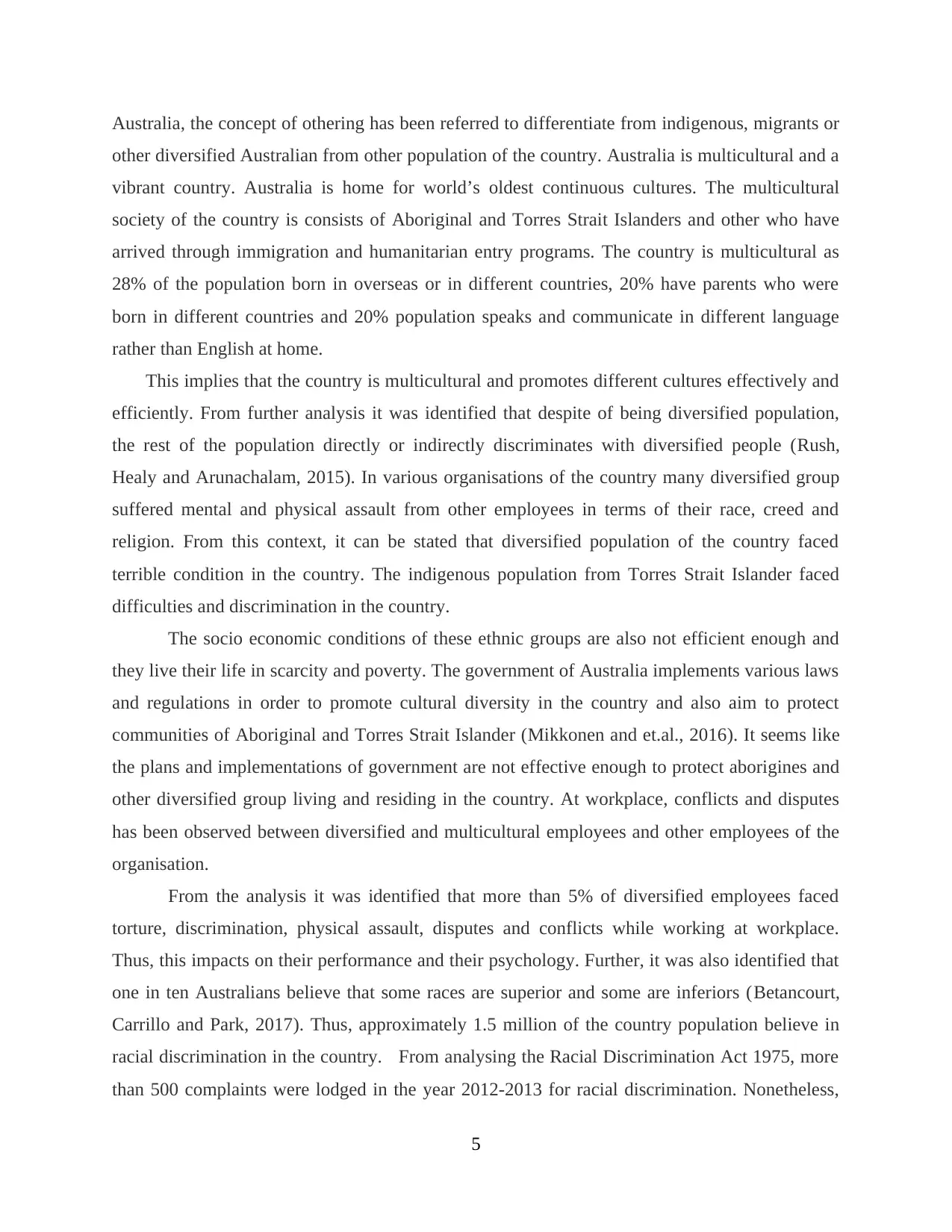
Australia, the concept of othering has been referred to differentiate from indigenous, migrants or
other diversified Australian from other population of the country. Australia is multicultural and a
vibrant country. Australia is home for world’s oldest continuous cultures. The multicultural
society of the country is consists of Aboriginal and Torres Strait Islanders and other who have
arrived through immigration and humanitarian entry programs. The country is multicultural as
28% of the population born in overseas or in different countries, 20% have parents who were
born in different countries and 20% population speaks and communicate in different language
rather than English at home.
This implies that the country is multicultural and promotes different cultures effectively and
efficiently. From further analysis it was identified that despite of being diversified population,
the rest of the population directly or indirectly discriminates with diversified people (Rush,
Healy and Arunachalam, 2015). In various organisations of the country many diversified group
suffered mental and physical assault from other employees in terms of their race, creed and
religion. From this context, it can be stated that diversified population of the country faced
terrible condition in the country. The indigenous population from Torres Strait Islander faced
difficulties and discrimination in the country.
The socio economic conditions of these ethnic groups are also not efficient enough and
they live their life in scarcity and poverty. The government of Australia implements various laws
and regulations in order to promote cultural diversity in the country and also aim to protect
communities of Aboriginal and Torres Strait Islander (Mikkonen and et.al., 2016). It seems like
the plans and implementations of government are not effective enough to protect aborigines and
other diversified group living and residing in the country. At workplace, conflicts and disputes
has been observed between diversified and multicultural employees and other employees of the
organisation.
From the analysis it was identified that more than 5% of diversified employees faced
torture, discrimination, physical assault, disputes and conflicts while working at workplace.
Thus, this impacts on their performance and their psychology. Further, it was also identified that
one in ten Australians believe that some races are superior and some are inferiors (Betancourt,
Carrillo and Park, 2017). Thus, approximately 1.5 million of the country population believe in
racial discrimination in the country. From analysing the Racial Discrimination Act 1975, more
than 500 complaints were lodged in the year 2012-2013 for racial discrimination. Nonetheless,
5
other diversified Australian from other population of the country. Australia is multicultural and a
vibrant country. Australia is home for world’s oldest continuous cultures. The multicultural
society of the country is consists of Aboriginal and Torres Strait Islanders and other who have
arrived through immigration and humanitarian entry programs. The country is multicultural as
28% of the population born in overseas or in different countries, 20% have parents who were
born in different countries and 20% population speaks and communicate in different language
rather than English at home.
This implies that the country is multicultural and promotes different cultures effectively and
efficiently. From further analysis it was identified that despite of being diversified population,
the rest of the population directly or indirectly discriminates with diversified people (Rush,
Healy and Arunachalam, 2015). In various organisations of the country many diversified group
suffered mental and physical assault from other employees in terms of their race, creed and
religion. From this context, it can be stated that diversified population of the country faced
terrible condition in the country. The indigenous population from Torres Strait Islander faced
difficulties and discrimination in the country.
The socio economic conditions of these ethnic groups are also not efficient enough and
they live their life in scarcity and poverty. The government of Australia implements various laws
and regulations in order to promote cultural diversity in the country and also aim to protect
communities of Aboriginal and Torres Strait Islander (Mikkonen and et.al., 2016). It seems like
the plans and implementations of government are not effective enough to protect aborigines and
other diversified group living and residing in the country. At workplace, conflicts and disputes
has been observed between diversified and multicultural employees and other employees of the
organisation.
From the analysis it was identified that more than 5% of diversified employees faced
torture, discrimination, physical assault, disputes and conflicts while working at workplace.
Thus, this impacts on their performance and their psychology. Further, it was also identified that
one in ten Australians believe that some races are superior and some are inferiors (Betancourt,
Carrillo and Park, 2017). Thus, approximately 1.5 million of the country population believe in
racial discrimination in the country. From analysing the Racial Discrimination Act 1975, more
than 500 complaints were lodged in the year 2012-2013 for racial discrimination. Nonetheless,
5
Paraphrase This Document
Need a fresh take? Get an instant paraphrase of this document with our AI Paraphraser
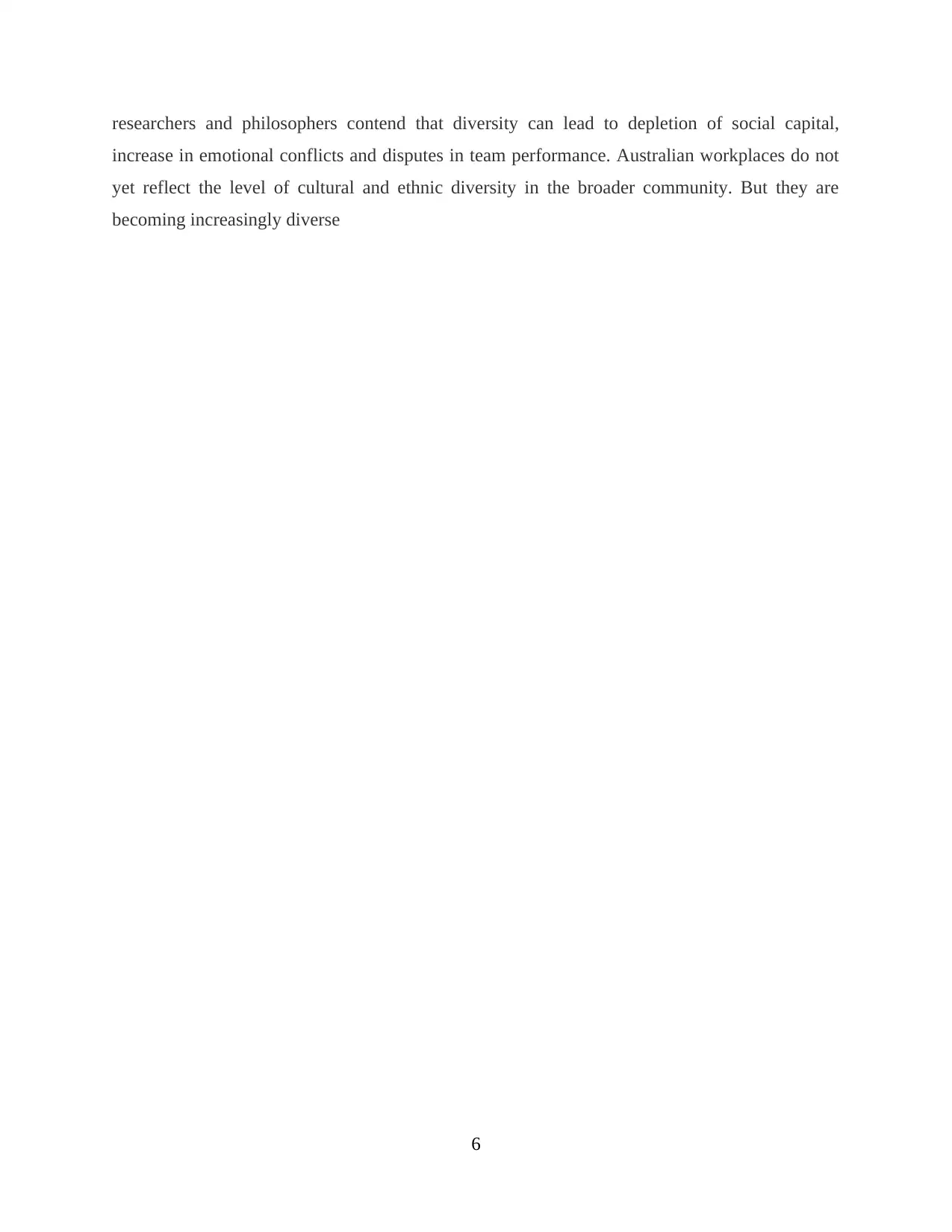
researchers and philosophers contend that diversity can lead to depletion of social capital,
increase in emotional conflicts and disputes in team performance. Australian workplaces do not
yet reflect the level of cultural and ethnic diversity in the broader community. But they are
becoming increasingly diverse
6
increase in emotional conflicts and disputes in team performance. Australian workplaces do not
yet reflect the level of cultural and ethnic diversity in the broader community. But they are
becoming increasingly diverse
6
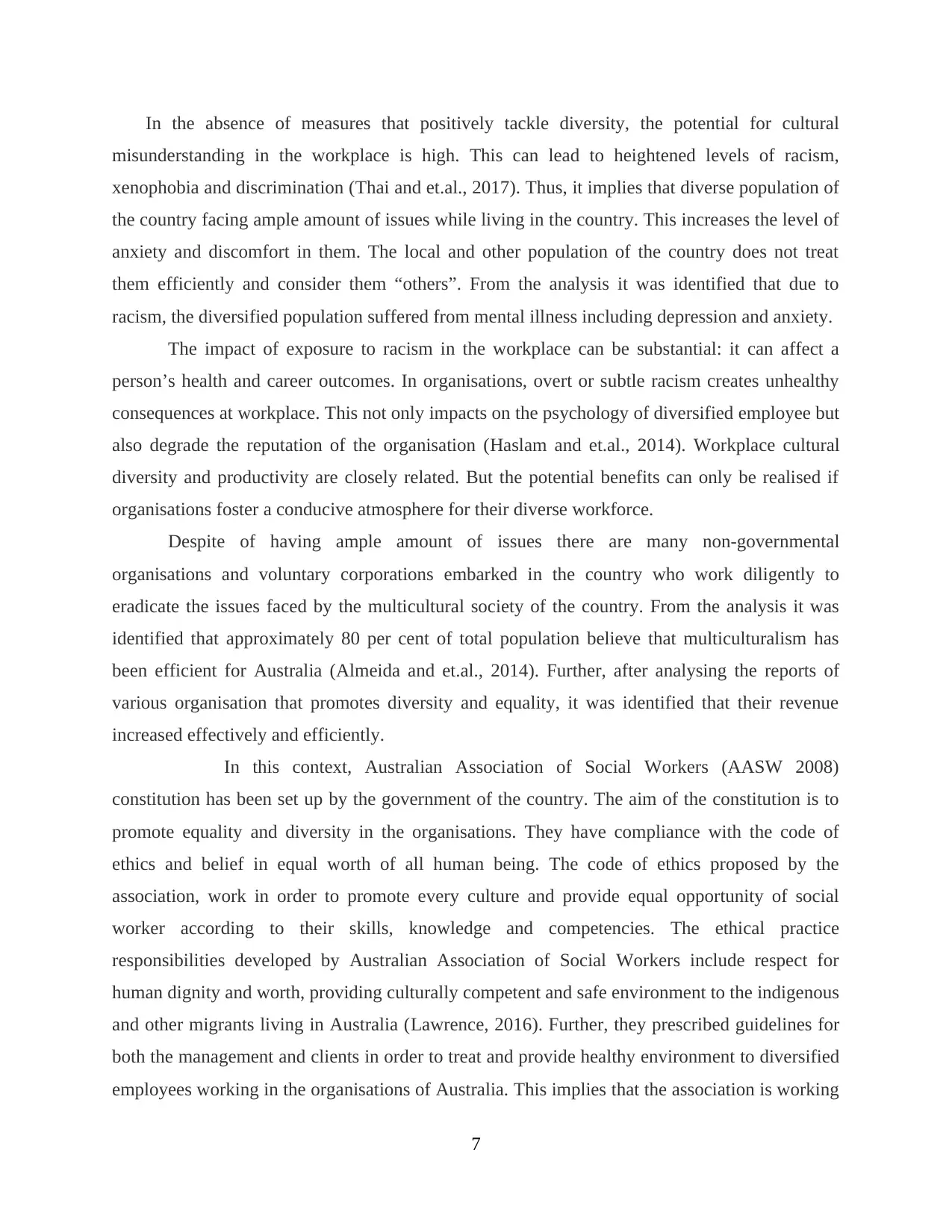
In the absence of measures that positively tackle diversity, the potential for cultural
misunderstanding in the workplace is high. This can lead to heightened levels of racism,
xenophobia and discrimination (Thai and et.al., 2017). Thus, it implies that diverse population of
the country facing ample amount of issues while living in the country. This increases the level of
anxiety and discomfort in them. The local and other population of the country does not treat
them efficiently and consider them “others”. From the analysis it was identified that due to
racism, the diversified population suffered from mental illness including depression and anxiety.
The impact of exposure to racism in the workplace can be substantial: it can affect a
person’s health and career outcomes. In organisations, overt or subtle racism creates unhealthy
consequences at workplace. This not only impacts on the psychology of diversified employee but
also degrade the reputation of the organisation (Haslam and et.al., 2014). Workplace cultural
diversity and productivity are closely related. But the potential benefits can only be realised if
organisations foster a conducive atmosphere for their diverse workforce.
Despite of having ample amount of issues there are many non-governmental
organisations and voluntary corporations embarked in the country who work diligently to
eradicate the issues faced by the multicultural society of the country. From the analysis it was
identified that approximately 80 per cent of total population believe that multiculturalism has
been efficient for Australia (Almeida and et.al., 2014). Further, after analysing the reports of
various organisation that promotes diversity and equality, it was identified that their revenue
increased effectively and efficiently.
In this context, Australian Association of Social Workers (AASW 2008)
constitution has been set up by the government of the country. The aim of the constitution is to
promote equality and diversity in the organisations. They have compliance with the code of
ethics and belief in equal worth of all human being. The code of ethics proposed by the
association, work in order to promote every culture and provide equal opportunity of social
worker according to their skills, knowledge and competencies. The ethical practice
responsibilities developed by Australian Association of Social Workers include respect for
human dignity and worth, providing culturally competent and safe environment to the indigenous
and other migrants living in Australia (Lawrence, 2016). Further, they prescribed guidelines for
both the management and clients in order to treat and provide healthy environment to diversified
employees working in the organisations of Australia. This implies that the association is working
7
misunderstanding in the workplace is high. This can lead to heightened levels of racism,
xenophobia and discrimination (Thai and et.al., 2017). Thus, it implies that diverse population of
the country facing ample amount of issues while living in the country. This increases the level of
anxiety and discomfort in them. The local and other population of the country does not treat
them efficiently and consider them “others”. From the analysis it was identified that due to
racism, the diversified population suffered from mental illness including depression and anxiety.
The impact of exposure to racism in the workplace can be substantial: it can affect a
person’s health and career outcomes. In organisations, overt or subtle racism creates unhealthy
consequences at workplace. This not only impacts on the psychology of diversified employee but
also degrade the reputation of the organisation (Haslam and et.al., 2014). Workplace cultural
diversity and productivity are closely related. But the potential benefits can only be realised if
organisations foster a conducive atmosphere for their diverse workforce.
Despite of having ample amount of issues there are many non-governmental
organisations and voluntary corporations embarked in the country who work diligently to
eradicate the issues faced by the multicultural society of the country. From the analysis it was
identified that approximately 80 per cent of total population believe that multiculturalism has
been efficient for Australia (Almeida and et.al., 2014). Further, after analysing the reports of
various organisation that promotes diversity and equality, it was identified that their revenue
increased effectively and efficiently.
In this context, Australian Association of Social Workers (AASW 2008)
constitution has been set up by the government of the country. The aim of the constitution is to
promote equality and diversity in the organisations. They have compliance with the code of
ethics and belief in equal worth of all human being. The code of ethics proposed by the
association, work in order to promote every culture and provide equal opportunity of social
worker according to their skills, knowledge and competencies. The ethical practice
responsibilities developed by Australian Association of Social Workers include respect for
human dignity and worth, providing culturally competent and safe environment to the indigenous
and other migrants living in Australia (Lawrence, 2016). Further, they prescribed guidelines for
both the management and clients in order to treat and provide healthy environment to diversified
employees working in the organisations of Australia. This implies that the association is working
7
⊘ This is a preview!⊘
Do you want full access?
Subscribe today to unlock all pages.

Trusted by 1+ million students worldwide
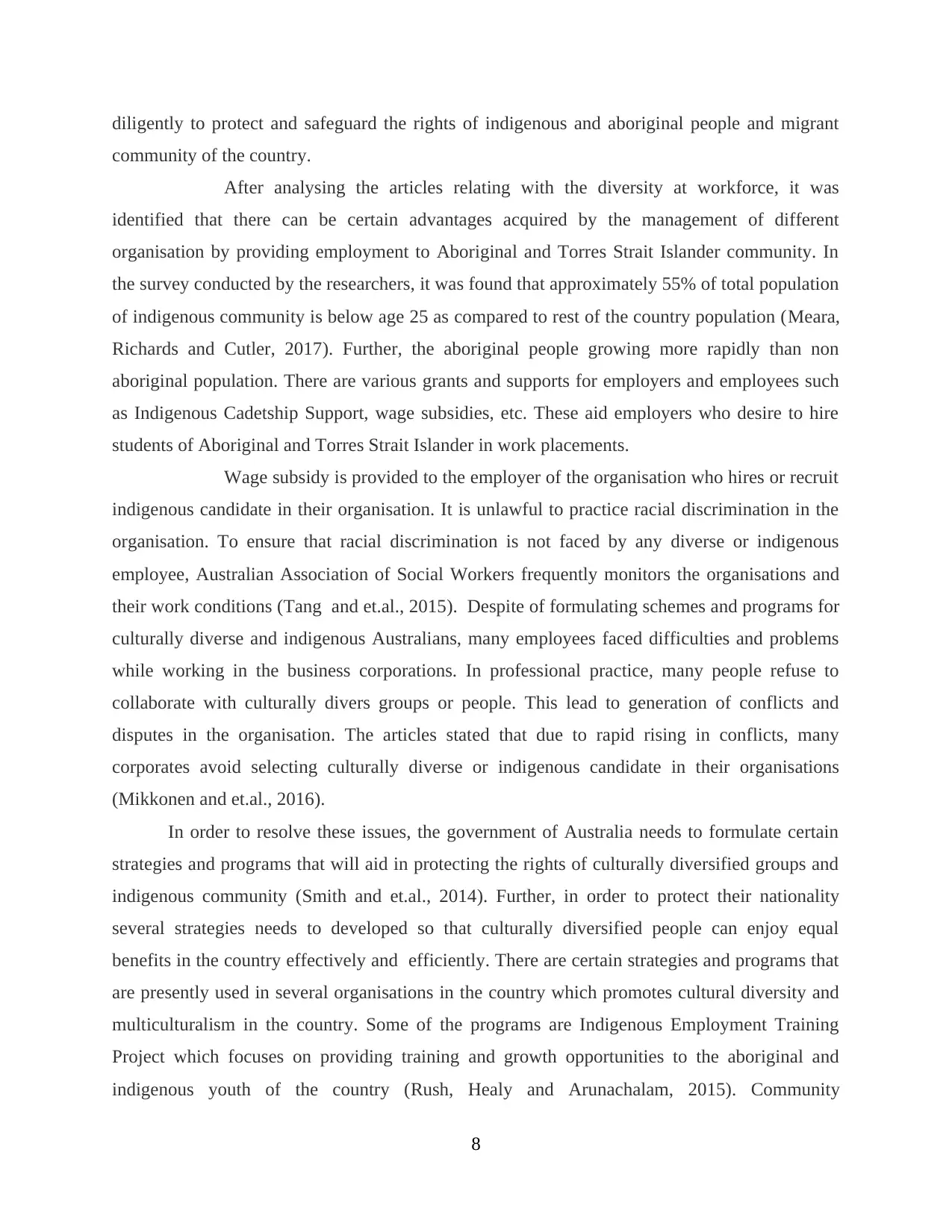
diligently to protect and safeguard the rights of indigenous and aboriginal people and migrant
community of the country.
After analysing the articles relating with the diversity at workforce, it was
identified that there can be certain advantages acquired by the management of different
organisation by providing employment to Aboriginal and Torres Strait Islander community. In
the survey conducted by the researchers, it was found that approximately 55% of total population
of indigenous community is below age 25 as compared to rest of the country population (Meara,
Richards and Cutler, 2017). Further, the aboriginal people growing more rapidly than non
aboriginal population. There are various grants and supports for employers and employees such
as Indigenous Cadetship Support, wage subsidies, etc. These aid employers who desire to hire
students of Aboriginal and Torres Strait Islander in work placements.
Wage subsidy is provided to the employer of the organisation who hires or recruit
indigenous candidate in their organisation. It is unlawful to practice racial discrimination in the
organisation. To ensure that racial discrimination is not faced by any diverse or indigenous
employee, Australian Association of Social Workers frequently monitors the organisations and
their work conditions (Tang and et.al., 2015). Despite of formulating schemes and programs for
culturally diverse and indigenous Australians, many employees faced difficulties and problems
while working in the business corporations. In professional practice, many people refuse to
collaborate with culturally divers groups or people. This lead to generation of conflicts and
disputes in the organisation. The articles stated that due to rapid rising in conflicts, many
corporates avoid selecting culturally diverse or indigenous candidate in their organisations
(Mikkonen and et.al., 2016).
In order to resolve these issues, the government of Australia needs to formulate certain
strategies and programs that will aid in protecting the rights of culturally diversified groups and
indigenous community (Smith and et.al., 2014). Further, in order to protect their nationality
several strategies needs to developed so that culturally diversified people can enjoy equal
benefits in the country effectively and efficiently. There are certain strategies and programs that
are presently used in several organisations in the country which promotes cultural diversity and
multiculturalism in the country. Some of the programs are Indigenous Employment Training
Project which focuses on providing training and growth opportunities to the aboriginal and
indigenous youth of the country (Rush, Healy and Arunachalam, 2015). Community
8
community of the country.
After analysing the articles relating with the diversity at workforce, it was
identified that there can be certain advantages acquired by the management of different
organisation by providing employment to Aboriginal and Torres Strait Islander community. In
the survey conducted by the researchers, it was found that approximately 55% of total population
of indigenous community is below age 25 as compared to rest of the country population (Meara,
Richards and Cutler, 2017). Further, the aboriginal people growing more rapidly than non
aboriginal population. There are various grants and supports for employers and employees such
as Indigenous Cadetship Support, wage subsidies, etc. These aid employers who desire to hire
students of Aboriginal and Torres Strait Islander in work placements.
Wage subsidy is provided to the employer of the organisation who hires or recruit
indigenous candidate in their organisation. It is unlawful to practice racial discrimination in the
organisation. To ensure that racial discrimination is not faced by any diverse or indigenous
employee, Australian Association of Social Workers frequently monitors the organisations and
their work conditions (Tang and et.al., 2015). Despite of formulating schemes and programs for
culturally diverse and indigenous Australians, many employees faced difficulties and problems
while working in the business corporations. In professional practice, many people refuse to
collaborate with culturally divers groups or people. This lead to generation of conflicts and
disputes in the organisation. The articles stated that due to rapid rising in conflicts, many
corporates avoid selecting culturally diverse or indigenous candidate in their organisations
(Mikkonen and et.al., 2016).
In order to resolve these issues, the government of Australia needs to formulate certain
strategies and programs that will aid in protecting the rights of culturally diversified groups and
indigenous community (Smith and et.al., 2014). Further, in order to protect their nationality
several strategies needs to developed so that culturally diversified people can enjoy equal
benefits in the country effectively and efficiently. There are certain strategies and programs that
are presently used in several organisations in the country which promotes cultural diversity and
multiculturalism in the country. Some of the programs are Indigenous Employment Training
Project which focuses on providing training and growth opportunities to the aboriginal and
indigenous youth of the country (Rush, Healy and Arunachalam, 2015). Community
8
Paraphrase This Document
Need a fresh take? Get an instant paraphrase of this document with our AI Paraphraser
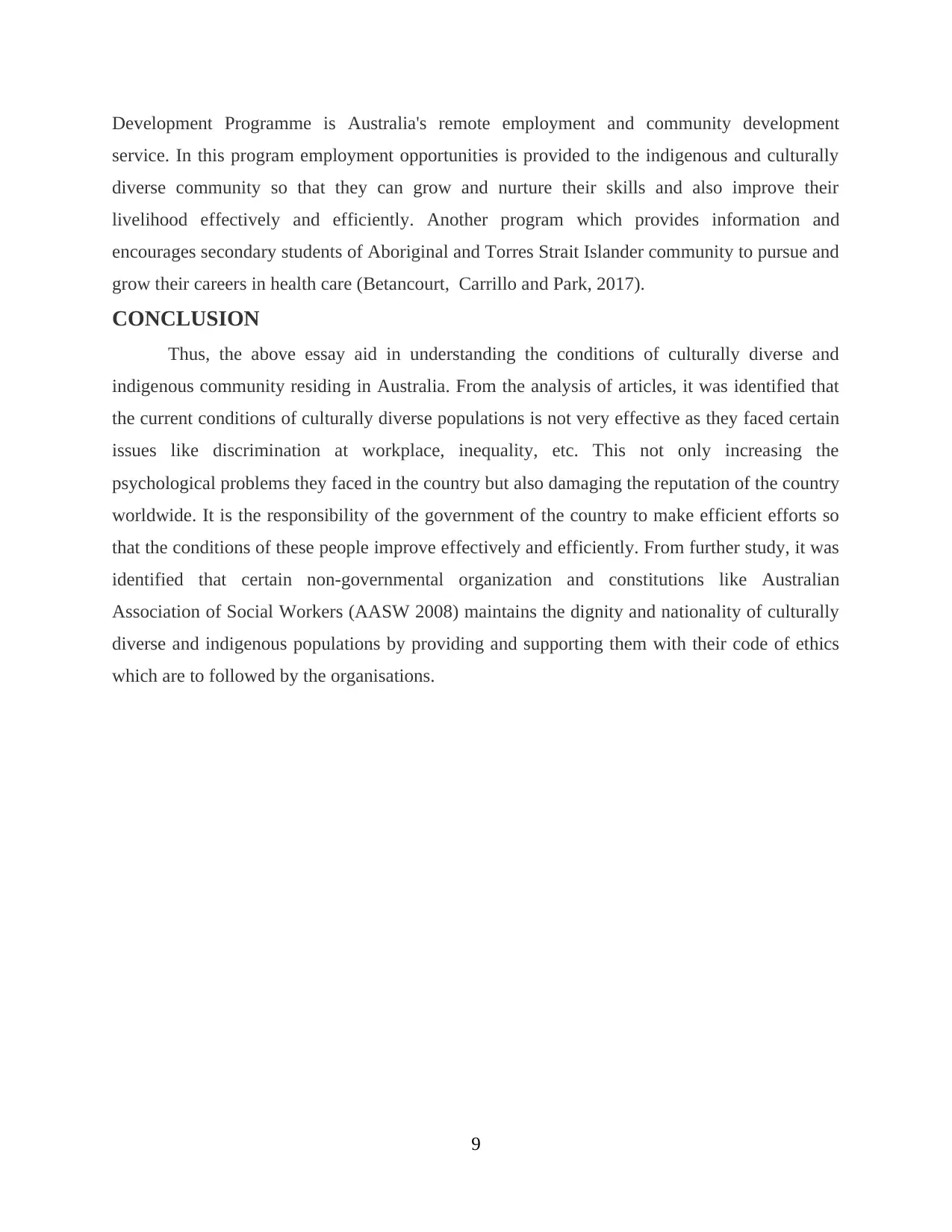
Development Programme is Australia's remote employment and community development
service. In this program employment opportunities is provided to the indigenous and culturally
diverse community so that they can grow and nurture their skills and also improve their
livelihood effectively and efficiently. Another program which provides information and
encourages secondary students of Aboriginal and Torres Strait Islander community to pursue and
grow their careers in health care (Betancourt, Carrillo and Park, 2017).
CONCLUSION
Thus, the above essay aid in understanding the conditions of culturally diverse and
indigenous community residing in Australia. From the analysis of articles, it was identified that
the current conditions of culturally diverse populations is not very effective as they faced certain
issues like discrimination at workplace, inequality, etc. This not only increasing the
psychological problems they faced in the country but also damaging the reputation of the country
worldwide. It is the responsibility of the government of the country to make efficient efforts so
that the conditions of these people improve effectively and efficiently. From further study, it was
identified that certain non-governmental organization and constitutions like Australian
Association of Social Workers (AASW 2008) maintains the dignity and nationality of culturally
diverse and indigenous populations by providing and supporting them with their code of ethics
which are to followed by the organisations.
9
service. In this program employment opportunities is provided to the indigenous and culturally
diverse community so that they can grow and nurture their skills and also improve their
livelihood effectively and efficiently. Another program which provides information and
encourages secondary students of Aboriginal and Torres Strait Islander community to pursue and
grow their careers in health care (Betancourt, Carrillo and Park, 2017).
CONCLUSION
Thus, the above essay aid in understanding the conditions of culturally diverse and
indigenous community residing in Australia. From the analysis of articles, it was identified that
the current conditions of culturally diverse populations is not very effective as they faced certain
issues like discrimination at workplace, inequality, etc. This not only increasing the
psychological problems they faced in the country but also damaging the reputation of the country
worldwide. It is the responsibility of the government of the country to make efficient efforts so
that the conditions of these people improve effectively and efficiently. From further study, it was
identified that certain non-governmental organization and constitutions like Australian
Association of Social Workers (AASW 2008) maintains the dignity and nationality of culturally
diverse and indigenous populations by providing and supporting them with their code of ethics
which are to followed by the organisations.
9
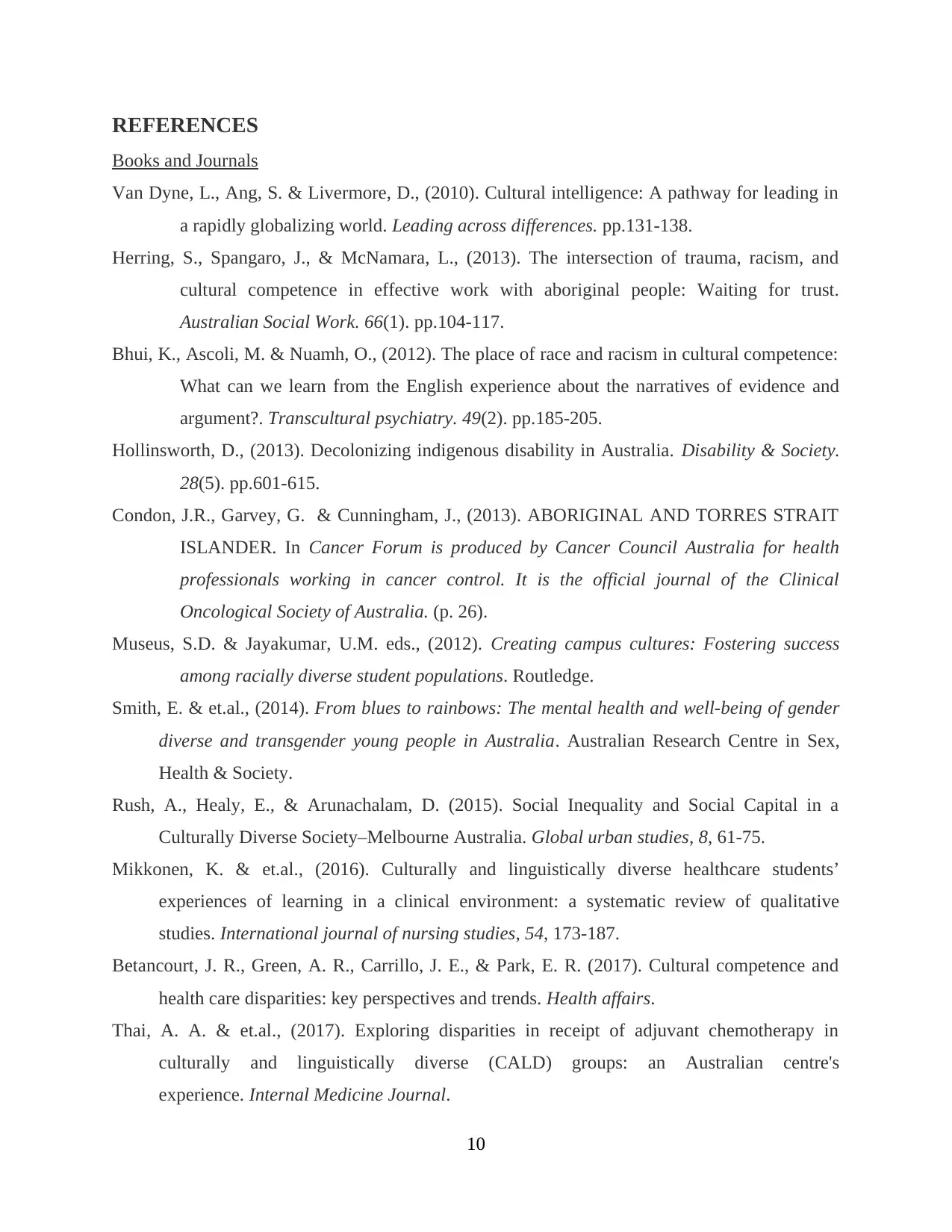
REFERENCES
Books and Journals
Van Dyne, L., Ang, S. & Livermore, D., (2010). Cultural intelligence: A pathway for leading in
a rapidly globalizing world. Leading across differences. pp.131-138.
Herring, S., Spangaro, J., & McNamara, L., (2013). The intersection of trauma, racism, and
cultural competence in effective work with aboriginal people: Waiting for trust.
Australian Social Work. 66(1). pp.104-117.
Bhui, K., Ascoli, M. & Nuamh, O., (2012). The place of race and racism in cultural competence:
What can we learn from the English experience about the narratives of evidence and
argument?. Transcultural psychiatry. 49(2). pp.185-205.
Hollinsworth, D., (2013). Decolonizing indigenous disability in Australia. Disability & Society.
28(5). pp.601-615.
Condon, J.R., Garvey, G. & Cunningham, J., (2013). ABORIGINAL AND TORRES STRAIT
ISLANDER. In Cancer Forum is produced by Cancer Council Australia for health
professionals working in cancer control. It is the official journal of the Clinical
Oncological Society of Australia. (p. 26).
Museus, S.D. & Jayakumar, U.M. eds., (2012). Creating campus cultures: Fostering success
among racially diverse student populations. Routledge.
Smith, E. & et.al., (2014). From blues to rainbows: The mental health and well-being of gender
diverse and transgender young people in Australia. Australian Research Centre in Sex,
Health & Society.
Rush, A., Healy, E., & Arunachalam, D. (2015). Social Inequality and Social Capital in a
Culturally Diverse Society–Melbourne Australia. Global urban studies, 8, 61-75.
Mikkonen, K. & et.al., (2016). Culturally and linguistically diverse healthcare students’
experiences of learning in a clinical environment: a systematic review of qualitative
studies. International journal of nursing studies, 54, 173-187.
Betancourt, J. R., Green, A. R., Carrillo, J. E., & Park, E. R. (2017). Cultural competence and
health care disparities: key perspectives and trends. Health affairs.
Thai, A. A. & et.al., (2017). Exploring disparities in receipt of adjuvant chemotherapy in
culturally and linguistically diverse (CALD) groups: an Australian centre's
experience. Internal Medicine Journal.
10
Books and Journals
Van Dyne, L., Ang, S. & Livermore, D., (2010). Cultural intelligence: A pathway for leading in
a rapidly globalizing world. Leading across differences. pp.131-138.
Herring, S., Spangaro, J., & McNamara, L., (2013). The intersection of trauma, racism, and
cultural competence in effective work with aboriginal people: Waiting for trust.
Australian Social Work. 66(1). pp.104-117.
Bhui, K., Ascoli, M. & Nuamh, O., (2012). The place of race and racism in cultural competence:
What can we learn from the English experience about the narratives of evidence and
argument?. Transcultural psychiatry. 49(2). pp.185-205.
Hollinsworth, D., (2013). Decolonizing indigenous disability in Australia. Disability & Society.
28(5). pp.601-615.
Condon, J.R., Garvey, G. & Cunningham, J., (2013). ABORIGINAL AND TORRES STRAIT
ISLANDER. In Cancer Forum is produced by Cancer Council Australia for health
professionals working in cancer control. It is the official journal of the Clinical
Oncological Society of Australia. (p. 26).
Museus, S.D. & Jayakumar, U.M. eds., (2012). Creating campus cultures: Fostering success
among racially diverse student populations. Routledge.
Smith, E. & et.al., (2014). From blues to rainbows: The mental health and well-being of gender
diverse and transgender young people in Australia. Australian Research Centre in Sex,
Health & Society.
Rush, A., Healy, E., & Arunachalam, D. (2015). Social Inequality and Social Capital in a
Culturally Diverse Society–Melbourne Australia. Global urban studies, 8, 61-75.
Mikkonen, K. & et.al., (2016). Culturally and linguistically diverse healthcare students’
experiences of learning in a clinical environment: a systematic review of qualitative
studies. International journal of nursing studies, 54, 173-187.
Betancourt, J. R., Green, A. R., Carrillo, J. E., & Park, E. R. (2017). Cultural competence and
health care disparities: key perspectives and trends. Health affairs.
Thai, A. A. & et.al., (2017). Exploring disparities in receipt of adjuvant chemotherapy in
culturally and linguistically diverse (CALD) groups: an Australian centre's
experience. Internal Medicine Journal.
10
⊘ This is a preview!⊘
Do you want full access?
Subscribe today to unlock all pages.

Trusted by 1+ million students worldwide
1 out of 13
Related Documents
Your All-in-One AI-Powered Toolkit for Academic Success.
+13062052269
info@desklib.com
Available 24*7 on WhatsApp / Email
![[object Object]](/_next/static/media/star-bottom.7253800d.svg)
Unlock your academic potential
Copyright © 2020–2025 A2Z Services. All Rights Reserved. Developed and managed by ZUCOL.





